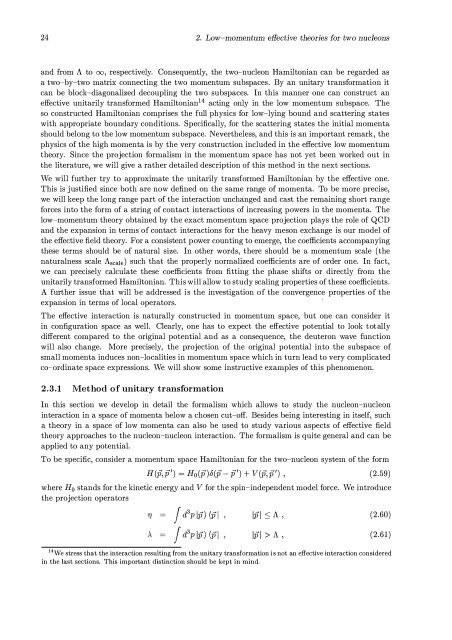The Nucleon-Nucleon Interaction in a Chiral Effective Field Theory
The Nucleon-Nucleon Interaction in a Chiral Effective Field Theory
The Nucleon-Nucleon Interaction in a Chiral Effective Field Theory
Create successful ePaper yourself
Turn your PDF publications into a flip-book with our unique Google optimized e-Paper software.
24 2. Low-momentum effective theories for two nuc1eons<br />
and from A to 00, respectively. Consequently, the two-nucleon Hamiltonian can be regarded as<br />
a two-by-two matrix connect<strong>in</strong>g the two momentum subspaces. By an unitary transformation it<br />
can be block-diagonalized decoupl<strong>in</strong>g the two subspaces. In this mann er one can construct an<br />
effective unitarily transformed Hamiltonian14 act<strong>in</strong>g only <strong>in</strong> the low moment um subspace. <strong>The</strong><br />
so constructed Hamiltonian comprises the full physics for low-Iy<strong>in</strong>g bound and scatter<strong>in</strong>g states<br />
with appropriate boundary conditions. Specifically, for the scatter<strong>in</strong>g states the <strong>in</strong>itial momenta<br />
should belong to the low momentum subspace. Nevertheless, and this is an important remark, the<br />
physics of the high momenta is by the very construction <strong>in</strong>cluded <strong>in</strong> the effective low moment um<br />
theory. S<strong>in</strong>ce the projection formalism <strong>in</strong> the moment um space has not yet been worked out <strong>in</strong><br />
the literature, we will give a rather detailed description of this method <strong>in</strong> the next sections.<br />
We will furt her try to approximate the unitarily transformed Hamiltonian by the effective one.<br />
This is justified s<strong>in</strong>ce both are now def<strong>in</strong>ed on the same range of momenta. To be more precise,<br />
we will keep the long range part of the <strong>in</strong>teraction unchanged and cast the rema<strong>in</strong><strong>in</strong>g short range<br />
forces <strong>in</strong>to the form of a str<strong>in</strong>g of contact <strong>in</strong>teractions of <strong>in</strong>creas<strong>in</strong>g powers <strong>in</strong> the momenta. <strong>The</strong><br />
low-momentum theory obta<strong>in</strong>ed by the exact moment um space projection plays the role of QCD<br />
and the expansion <strong>in</strong> terms of contact <strong>in</strong>teractions for the heavy meson exchange is our model of<br />
the effective field theory. For a consistent power count<strong>in</strong>g to emerge, the coefficients accompany<strong>in</strong>g<br />
these terms should be of natural size. In other words, there should be a momenturn scale (the<br />
naturalness scale Ascale) such that the properly normalized coefficients are of order one. In fact,<br />
we can precisely calculate these coefficients from fitt<strong>in</strong>g the phase shifts or directly from the<br />
unitarily transformed Hamiltonian. This will allow to study scal<strong>in</strong>g properties of these coefficients.<br />
A furt her issue that will be addressed is the <strong>in</strong>vestigation of the convergence properties of the<br />
expansion <strong>in</strong> terms of local operators.<br />
<strong>The</strong> effective <strong>in</strong>teraction is naturally constructed <strong>in</strong> moment um space, but one can consider it<br />
<strong>in</strong> configuration space as weIl. Clearly, one has to expect the effective potential to look totally<br />
different compared to the orig<strong>in</strong>al potential and as a consequence, the deuteron wave function<br />
will also change. More precisely, the projection of the orig<strong>in</strong>al potential <strong>in</strong>to the subspace of<br />
small momenta <strong>in</strong>duces non-Iocalities <strong>in</strong> momentum space which <strong>in</strong> turn lead to very complicated<br />
co-ord<strong>in</strong>ate space expressions. We will show so me <strong>in</strong>structive examples of this phenomenon.<br />
2.3.1 Method of unitary transformation<br />
In this section we develop <strong>in</strong> detail the formalism which allows to study the nucleon-nucleon<br />
<strong>in</strong>teraction <strong>in</strong> a space of momenta below a chosen cut-off. Besides be<strong>in</strong>g <strong>in</strong>terest<strong>in</strong>g <strong>in</strong> itself, such<br />
a theory <strong>in</strong> a space of low momenta can also be used to study various aspects of effective field<br />
theory approaches to the nucleon-nucleon <strong>in</strong>teraction. <strong>The</strong> formalism is quite general and can be<br />
applied to any potential.<br />
To be specific, consider a momenturn space Hamiltonian for the two-nucleon system of the form<br />
H(p,p') = Ho (p)J(p -p') + V(p, p') , (2.59)<br />
where Ho stands for the k<strong>in</strong>etic energy and V for the sp<strong>in</strong>-<strong>in</strong>dependent model force. We <strong>in</strong>troduce<br />
the projection operators<br />
! d3p lp) (pl<br />
! d3p Ip) (pi<br />
Ipl � A,<br />
Ipl > A,<br />
(2.60)<br />
(2.61)<br />
14 We stress that the <strong>in</strong>teraction result<strong>in</strong>g from the unitary transformation is not an effective <strong>in</strong>teraction considered<br />
<strong>in</strong> the last sections. This important dist<strong>in</strong>ction should be kept <strong>in</strong> m<strong>in</strong>d.












